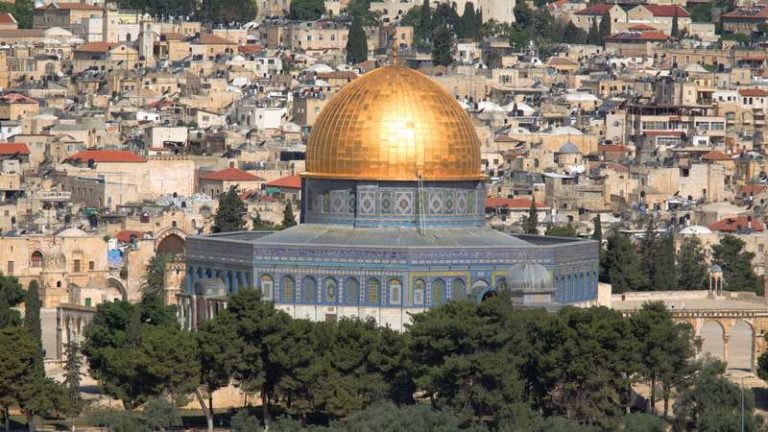What places do you consider most holy and special? Why?
The Holy Land is full of sites of cultural, religious, and historic significance to Jews, Christians, and Muslims alike. Some of the most important locations in the Muslim world can be found in the Holy Land. Here are some of the top Muslim sites to visit in the Holy Land.
- The Dome of the Rock, Jerusalem: Islam’s third holiest site sits on the Temple Mount in the Old City of Jerusalem. This shrine was completed in 692 AD. Inside is the foundation stone that marks the spot where the prophet Muhammad began his Night Journey. It also said that the foundation stone was the first thing God created when forming the world. The building is decorated with beautiful mosaics and its sparkling golden dome has become an iconic part of Jerusalem’s skyline.
- Dome of the Ascension, Jerusalem: This small free-standing stone domed structure is located just to the north of the Dome of the Rock. It also marks the spot where the prophet Muhammad ascended to Heaven. It is part of the Muslim Prayer Route. It’s not known who built it or when, but it was rebuilt and rededicated as a Muslim holy site in 1200 AD.
- Al-Aqsa Mosque, Jerusalem: This silver domed mosque sits on the Temple Mount. It was completed in 705 AD and is the second oldest mosque in the world and one of the holiest sites in Islam. Its name literally means “the farthest” and is interpreted to mean the farthest from Mecca. This is because during the prophet Muhammad’s Night Journey he was transported from the Great Mosque of Mecca to Al-Aqsa. The 35 acres compound the mosque is a part of is called Al Haram Ash Sharif t which means “The Noble Sanctuary.”
- Mosque of Omar, Jerusalem: This mosque is located across from the Church of the Holy Sepulcher. It was constructed in the 12th century on the site where Caliph Omar Ibn al-Khattab accepted Jerusalem’s surrender from the Byzantine’s in 638 AD. Omar traveled to Jerusalem to accept the surrender of the city’s Patriarch. The Patriarch offered Caliph Omar to pray inside the Church of the Holy Sepulcher, but Omar knew that if he did so the church would lose its Christian status. He decided to preserve the church’s status and prayed in the courtyard. The spot where he prayed is where the mosque was built.
- The Lady Tonsok Palace Façade, Jerusalem: Lady Tonsok was the wife of the Mameluk ruler Muthaffar al-Din. She dedicated the façade of their palace to a group of Muslim mystics called the Sufi Order in the 14th While the palace’s facade has suffered erosion some of the beautiful inlaid marbled doorways are still visible.
- The Muslim Quarter, Jerusalem: The Muslim Quarter is the largest of the four neighborhoods that make up Jerusalem’s Old City. The Muslim Quarter is a bustling hub for pilgrims and shoppers alike. There are many beautiful buildings from a range of architectural traditions. The Quarter is also known for its grand markets full of vendors selling spices, clothing, souvenirs, traditional foods, and much more.
- The Old City Souk, Jerusalem: In the center of the Muslim Quarter lies a particularly large sprawling open air market. This is Suq al-Qattatin, considered to be the most beautiful of the souk markets. It is a covered bazaar that specializes in cotton merchants. Cloth of every shape and color line this labyrinthine market.
- Sanctuary of Abraham/Al-Haram Al-Ibrahimi/The Tomb of Patriarchs, Hebron: This is the fourth holiest site in Islam. The tomb itself is a series of caves purchased by Abraham as a burial plot. It is also the site of the Ibrahimi Mosque, built in 1188. There is a footprint in a corner of the mosque that is believed to have been left by Mohammad himself during his Night Journey.
- The Tomb of Samuel-Nebi Samuel, Nabi Samwil: This is the tomb of the prophet Samuel. Samuel shifted Israel from being ruled by judges to be ruled by kings. He anointed both King Saul and King David. The tomb is built on the ruins of a church and contains a Mosque and small synagogue beneath it; truly a place sacred to Muslims, Jews, and Christians alike.
- El-Jazzar Mosque, Acre: Also known as the White Mosque, it overlooks the Mediterranean Sea and was named after an Ottoman Bosnian governor named Ahmad Pasah el-Jazzar. The mosque was built in 1781. Most of the building’s materials were harvested from the ruins of Caesarea and Atlit. The mosque houses the Sha’r an-Nabi, a lock of hair from the prophet Muhammad’s beard.





